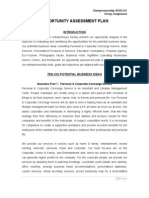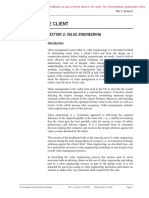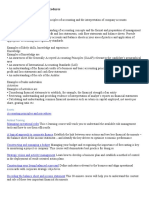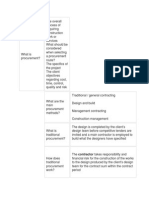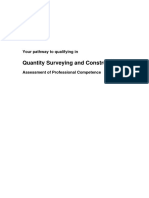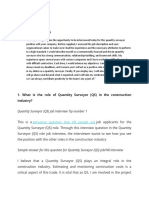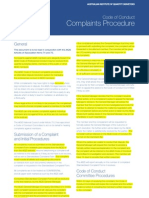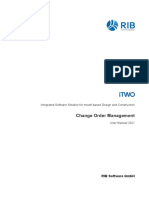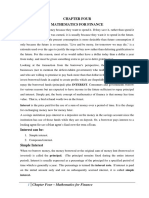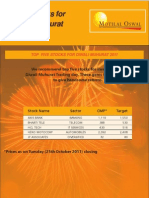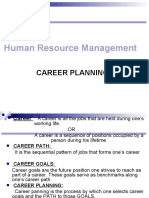RICS Pathway Guide QS
RICS Pathway Guide QS
Uploaded by
Roshan NizamCopyright:
Available Formats
RICS Pathway Guide QS
RICS Pathway Guide QS
Uploaded by
Roshan NizamCopyright
Available Formats
Share this document
Did you find this document useful?
Is this content inappropriate?
Copyright:
Available Formats
RICS Pathway Guide QS
RICS Pathway Guide QS
Uploaded by
Roshan NizamCopyright:
Available Formats
Pathway guide 1 2 3 4 5
Study checklist
• Insolvency • Establishing client’s brief
In this section the competencies are broken down
into a list of topics to help candidates make sure • Legislation • Site investigation
they have covered everything that is appropriate to • Feasibility studies
their journey through the pathway competencies.
Business planning • Procurement reports
The lists are not meant to be prescriptive. They Level 1 • Project programme
are not comprehensive, nor must a candidate • Communication strategy
• Legislation
necessarily cover every topic. Candidates should • Key Performance Indicators
• Types of business – Partnerships, Limited
be aware that they must consider how the law in
companies, Limited Liability Partnerships (LLP) • Stakeholder management
their world region impacts on each of the individual
competencies. This list is not exhaustive. • Short/long term strategies
• Market analysis
Communication and negotiation
Generally, you should be reading articles in current
• Five year plans Level 2
copies of:
• Objectives – markets, clients, turnover, staffing, • Oral communication:
• RICS Modus and Construction Journal acquisitions • Phone calls
• RICS communications • Resourcing – recruitment, training, financing, • Telephone/video conferencing
• Other construction and property journals accommodation
• Reporting at meetings
• Quality newspapers • SWOT analysis
• Facilitating/chairing meeting
• Human resources
• Client and bid presentations
Mandatory • Data management
• Administration
• Staff presentations
competencies • Health and safety
• Contractor/consultant interviews
• Public speaking at seminars etc.
• Equality
• Listening skills
Accounting principles and • Legislation
• Written/graphical communication
procedures • Letters, emails and other electronic
Client care
Level 1 communication
Level 2 • Report writing
• Balance sheets/profit and loss account
• Appointment documents • Programming
• Taxation
• Fees • Using drawn information – checking scales and
• Revenue and capital expenditure
• Prequalification Questionnaires (PQQ) revisions
• Cash flows
• Invitation to Tender (ITT) • Using CAD documents
• Auditing
• Complaints procedures • Using BIM [Building Information Modelling]
• Ratio analysis
• Insurance
• Credit control
• Understanding client objectives
• Profitability
Quantity Surveying and Construction 64
Pathway guide 1 2 3 4 5
Negotiation Data management Diversity, inclusion and team
• Establishing authority Level 1 working
• Establishing objectives • BCIS/BMI or other external sources Level 1
• Setting strategy • Employer’s in-house cost data storage and • Equality
• Collecting and presenting evidence filing • Understand the role of team members
• Record keeping • Pricing books • Appointing the project team
• Elemental analysis • Relationships with other team members
Ethics, Rules of Conduct and pro- • Data base use generally • Communicating with other team members
fessionalism • Business management systems • Partnering and collaborative working
Level 3 • Scheduling • RACI matrix
• RICS Rules of Conduct [for individuals and • Libraries • Strategic alliance
firms] • Storage of project data • Supply chain management
• Conduct befitting a Chartered Surveyor • Building Information Modelling (BIM) • Legislation on selecting project teams
• Registration of firms • Project intranets and extranets • Accountability and responsibility
• Complaints procedure • Appropriate legislation dictating the storage and
• Conflicts of interest sharing of information Inclusive environments
• Gifts Level 1
Health and safety • Recognising diverse user needs in respect of
• Professional Indemnity Insurance
• Client accounts Level 2 age, gender, ability, ethnicity, religion, etc.
• Regulation • Personal health and safety at work – RICS • Equality legislation
• Disciplinary procedures publication ‘Surveying Safely’ Personal safety • Planning legislation and requirements
procedures when visiting a construction site • Building regulations and codes
• Lifelong learning – CPD
Common health and safety risks in construction • Accessibility
• Current RICS structure
Health and safety legislation:
• Professional Group • Visual clarity
• Generally
• Current RICS issues and initiatives • Audibility systems
• At work
• Employment law
Conflict avoidance, management • Construction specific
• Impact of health and safety regulations
• Sector specific
and dispute resolution procedures • Corporate policy
• Client specific
• Ethical considerations as opposed to legal
Level 1 • Asbestos and other hazardous materials requirements
See Optional competencies
Sustainability Leadership
Level 1 Level 2
See Optional competencies • Self-management
• Leadership styles
Quantity Surveying and Construction 65
Pathway guide 1 2 3 4 5
• The role of a leader
• Organising
Core Competencies • Letters of intent – Comfort letters/Consent to
spend /Recognition of contract
• Planning techniques • Performance security – Bonds/Parent Company
• Setting goals
Commercial management Guarantees
• Decision making (of construction works) • Insurances
• Communication • Advance payments
Level 3
• Negotiation • Interim valuations and payment provisions
• Estimating
• Supervision • Materials on/off site
• Tendering
• Fluctuations
• Profitability
Managing people • Retention – retention bonds
• competitiveness
Level 2 • Change procedures
• Establishing budgets
• Valuing change – variations/compensation
• Recruitment • Cash flows
events
• Appraisals • Reporting financial progress against budget
• Extensions of time
• Personnel development • Procurement of labour
• Claims/Loss and Expense
• Incentive schemes • Procurement of plant and materials
• Dispute avoidance and resolution
• Communication • Procurement of sub-contracts
• Named/Nominated subcontractors
• Employment law • Financial management of supply chain
• Sectional Completion/Partial Possession
• Employment policy • Financial management of multiple projects
• Design Portions/Performance specified works
• Human rights legislation • Earned Value management
• Determination
• Delegation • Cost Value Reconciliation (CVR)
• Final Accounts
• Empowering
• Mentoring
Contract practice • Completion
• Liquidated/delay damages
• HR policy Level 3
• Defects liability/rectification period
• Stakeholder management • Principles of contract law • Construction technology and environmental
• Legislation services
Managing resources [excluding • Current case-law – look out for cases reported
human resources] in journals Construction technology and
Level 2 • Standard forms of main and sub contract – e.g. environmental services
FIDIC, JCT, NEC, ICC, ACA, IChemE, etc.
• Data communication systems Level 3
• Roles & responsibilities of parties – Client, Con-
• Stationery tract Administrator/Employer’s Agent/Project Buildings:
• Secretarial/administration support services manager/Engineer, Contractor, Sub-contrac- • Substructures – basements, types of piling, etc.
• Space planning tors, Quantity Surveyor
• Superstructures
• Facilities management • Assignment/Novation
• Comparison of concrete/steel frames
• Hot desking • Third party rights – Legislation/Collateral War-
• Floor structures
• Homeworking ranties
Quantity Surveying and Construction 66
Pathway guide 1 2 3 4 5
• External walls, windows and doors Design economics and cost Procurement and tendering
• Cladding/glazing
planning Level 3
• Roof structures and coverings
• Partitioning systems and doors Level 3 • Types of procurement:
• Finishes and fixtures • Economics of design – site density, wall/floor • Traditional
• Hard and soft landscaping ratio, storey heights, room sizes, letable/non- • Design and Build
letable • Management Contracting
• Services technology
• Sources of cost data – BCIS/in-house data- • Construction Management
• Electrical systems
base/other external sources • Financial basis
• Mechanical systems
• Inflation (tender/construction) • Lump sum
• Internal/external drainage
• Location factors, regional variations • Re-measured
• Mains services
• Currency fluctuations • Cost Reimbursable
• Air-conditioning/ventilation systems
• Order of Cost Estimates • Target cost
• Fire safety systems
• Elemental Cost Plans • Management contracts
• Security systems
• Cost Planning • Tendering
• Environmental systems and controls
• Life cycle costing – capital/running costs/re- • Standard rules of tendering – codes of practice,
• Data systems
placement practice notes
• Building types and other structures
• Whole life costing • Single/two-stage tendering – competitive/ne-
• Building regulations and codes
• Value Engineering gotiated
• Planning legislation and procedures
• Value Management • Electronic tendering
• Party wall issues/rights of light
• Risk Management and Analysis (contingency) • Compilation of tender lists – pre-qualifying
• Dangerous/banned substances – asbestos etc.
• State of the construction market contractors
• Pre-fabrication
• State of the economy generally – locally and • Compilation of tender documents
• Disability legislation globally • Pre and Post tender estimates
Engineering structures: • Interest rates • Tender analysis
• Bridges • New Rues of Measurement (NRM 1 and 3) • Tender reports
• Tunnels • BCIS Standard Form of Cost Analysis • Partnering – project and strategic
• Roads • Building Information modelling (BIM)
• Railways • RICS Code of Measurement Practice Project finance (control and
• Water ways • International Property measurement Standards reporting)
• Sea defences (IPMS)
Level 3
• Earthworks • International Construction Measurement Stand-
• Post contract cost control
ards (ICMS)
• Sewage treatment plants • Change control procedures
Energy plants and installations: • Change control forms
• Processing plant • Cost reporting
• Final accounts
Quantity Surveying and Construction 67
Pathway guide 1 2 3 4 5
• Loss and expense • Interim valuations Conflict avoidance, management
• Risk management and quantification • Valuing change
and dispute resolution procedures
• Cash flows • Loss and expense
• Value engineering • Final account • How standard forms of contract deal with con-
flict avoidance and dispute resolution
• Benchmarking/Best value • Reporting on cost
• Conflict avoidance
• Tender report
Quantification and costing (of • Correcting errors in tenders
• Partnering
construction works) • Post contract financial reporting
• Negotiation
• Mediation
Level 3
• Methods of measurement Optional competencies • Conciliation
• Adjudication
• New Rules of Measurement (NRM Volumes 1 • Arbitration
to 3) Capital allowances • Pre-action Protocol
• Other methods of measurement – e.g.
• Current legislation • Litigation
CESMM, POMI
• Capital and revenue expenditure • Expert Witness
• RICS Code of Measurement Practice
• Taxation • Independent Expert Determination
• International Property Measurement Standards
• Capital Allowances legislation • Scott schedules
(IPMS)
• Claiming capital allowances
• BIM
• Plant and machinery Contract administration
• Inputting data in to BIM
• Integral features • Standard forms of Contract – e.g. FIDIC, JCT,
• Extracting data from BIM
• Industrial buildings NEC, ACA, ICC, IChemE, etc.
• Preparation of pricing documents
• Hotels • Roles and responsibilities of parties – client,
• Tender documents generally
• Research and development contractors, designers, Q.S
• Bill of quantity
• Enterprise zones • Role and responsibilities of person administer-
• Schedule of works
• First year allowances ing the contract – e.g. Contract Administrator,
• Schedule of rates Architect, Employer’s Agent, Project Manager,
• Enhanced capital allowances
• Provisional Sums/Prime Cost Sums Engineer, Client Representative etc.
• Analysis of price Commercial management (of • Co-ordination of parties
• Tender returns
construction works) • Design co-ordination
• Target cost – Pain/Gain mechanisms • Planning and building regulatory controls
• Loss and expense (If not selected as a Core competency - see above)
• Health & Safety
• Preliminaries • Monitoring progress
• Day works • Monitoring quality
• Valuation of works • Insurances
Quantity Surveying and Construction 68
Pathway guide 1 2 3 4 5
• Bonds/Parent Company Guarantees Due Diligence Programming and planning
• Third party rights
• Project monitoring on management style • Project programming
• Payment provisions
contracts • Multi-project programming
• Change procedures
• Fund monitoring • Flow diagrams
• Sectional Completion/Partial Possession
• Feasibility study • Activity schedules
• Nominated/Named Subcontractors
• Planning and building regulatory control • Gantt charts
• Extensions of time/loss and expense
• Suitability of team • Critical path
• Materials on/off site
• Suitability of procurement route • Key milestones
• Determination
• Tendering • Float
• Liquidated/delay damages
• Contractual arrangements • Cash flows
• Completion
• Third-party rights • Progress monitoring
• Defects/rectification period
• Suitability of programme • Project handbook
Corporate recovery and insolvency • Cash flows • Project Execution Plans – PEP
• Interim payments • Establishing team
• Types of Insolvency
• Draw-down • Roles and responsibilities
• Bankruptcy
• Final accounts • Commissioning/handover procedure
• Individual voluntary arrangement
• Risk • Close-out reports
• Liquidation
• Administrative receivership/Fixed charge Insurance Project feasibility analysis
receivership
• Professional Indemnity Insurance – generally • Appraisal methods
• Company voluntary arrangement
and RICS requirements • Residual value
• Role of the QS if insolvency occurs
• Indemnifying the employer • Value/income
• Termination and suspension of contracts
• Third-party liability – persons and property • Valuation of property/rental values
• Assignment/novation
• Insurance of the works – joint names • RICS Red Book
• Ownership of material and plant
• Subrogation • Costs
• Bonds and guarantees
• Non-negligence insurance • Land acquisition
• Set-off
• Setting level of cover • Construction costs
• RICS Information Paper on Construction
• In the aggregate/each and every event • Fees
Insolvency
• Excess • Finance costs
Design economics and • Net contribution clause • Taxation, grants, capital allowances
cost planning • Performance bonds • Profitability
• Fire insurance valuations • Planning
(If not selected as a Core competency – see above)
Quantity Surveying and Construction 69
Pathway guide 1 2 3 4 5
Risk management Sustainability
• Sustainable development/construction
• Workshops
• National and international regulations
• Identification
• Environmental assessment methods – e.g. SKA
• Register
Rating, LEED, BREEAM, National Technical
• Management plan Standards, etc.
• Mitigation • Building Regulations and Codes
• QS contribution to risk management • Contaminated land
• Risk analysis • Waste management
• Probability and impact • Recyclable materials
• Expected Monetary Value – EMV • Sustainable materials
• Monte Carlo Simulation • Building environmental management systems
• Central Limit Theory – CLT • Water conservation
• Route Mean Square – RMS • Energy generation
• Quantified risk allowances • Energy conservation
• Life cycle cost studies
• Whole life cost studies
• Cost benefit analysis
• Carbon estimating
• Energy Performance Certificates
• Display Energy Certificates
Quantity Surveying and Construction 70
You might also like
- Assignment 320 PDFDocument18 pagesAssignment 320 PDFMuhammad Usman100% (1)
- Opportunity Assessment PlanDocument18 pagesOpportunity Assessment PlanSteffie67% (6)
- Rics - Presentation PDFDocument39 pagesRics - Presentation PDFrthomsanNo ratings yet
- All About Pasalubong Center 2 D R A F TDocument14 pagesAll About Pasalubong Center 2 D R A F TEGUIA, MARY SHENIETH M.100% (4)
- QS Roles in Riba Plan of Work 2020Document2 pagesQS Roles in Riba Plan of Work 2020NUR IRDINA NABILA EFFENDY100% (1)
- Assignment - Professional Commiunications and Negotiation Skills-1Document5 pagesAssignment - Professional Commiunications and Negotiation Skills-1LokuliyanaN33% (3)
- CPD On Ethical Landscape in Quantity Surveying (Bahrain 2016)Document25 pagesCPD On Ethical Landscape in Quantity Surveying (Bahrain 2016)chandanaNo ratings yet
- AIQS AcademyDocument7 pagesAIQS AcademyyohanjNo ratings yet
- Surveyors Construction Handbook Value EngineeringDocument15 pagesSurveyors Construction Handbook Value EngineeringSithick MohamedNo ratings yet
- 03 Communication - and - Negotiation - m004 - PDFDocument3 pages03 Communication - and - Negotiation - m004 - PDFJasmine TsoNo ratings yet
- M003 Client CareDocument4 pagesM003 Client Caresharfutaj100% (1)
- AssocRICS Direct Entry Qualifications (May 2017)Document9 pagesAssocRICS Direct Entry Qualifications (May 2017)Abu MuhammadNo ratings yet
- Free RICS APC Revision Quiz - Inspection SurveyDocument1 pageFree RICS APC Revision Quiz - Inspection SurveySignoreNo ratings yet
- RICS CompetencyDocument2 pagesRICS CompetencySujithNo ratings yet
- Complete 2.0Document24 pagesComplete 2.0Fu Fu XiangNo ratings yet
- FinalSubmission - Vedhakumar RamadossDocument42 pagesFinalSubmission - Vedhakumar RamadossDXBGs - BotNo ratings yet
- FinalSubmission - Ishara MadusankaDocument50 pagesFinalSubmission - Ishara MadusankaDXBGs - BotNo ratings yet
- Training For Contract AdministrationDocument2 pagesTraining For Contract AdministrationEdward LamNo ratings yet
- QuestionsDocument9 pagesQuestionssampath_priyashanthaNo ratings yet
- Associate Assessment Submission Document FinalDocument13 pagesAssociate Assessment Submission Document FinalAshraf MohamedNo ratings yet
- Assessment of Professional Competence (QS) PDFDocument13 pagesAssessment of Professional Competence (QS) PDFadon97No ratings yet
- SOE-Guide-Project Financial ControlDocument10 pagesSOE-Guide-Project Financial ControlPratik ChouguleNo ratings yet
- Nasser Alomari SummariesOfExperienceDocument11 pagesNasser Alomari SummariesOfExperiencejointokashifNo ratings yet
- RICS IConsult - RICS Draft Guidance Note - Developing A Building Procurement Strategy and Selecting An Appropriate Procurement Route APPENDIXDocument4 pagesRICS IConsult - RICS Draft Guidance Note - Developing A Building Procurement Strategy and Selecting An Appropriate Procurement Route APPENDIXDivina Teja Rebanal-GlinoNo ratings yet
- Study On Different Types of Tenders, Tender Qualification/ Processing, Quantitative Techniques For Tendering, Planning and Monitoring-A ReviewDocument4 pagesStudy On Different Types of Tenders, Tender Qualification/ Processing, Quantitative Techniques For Tendering, Planning and Monitoring-A ReviewAanchal MishraNo ratings yet
- RICSNew Rulesof Measurement PLPPresentation 20090520Document30 pagesRICSNew Rulesof Measurement PLPPresentation 20090520Kevin DonNo ratings yet
- Details of Malmaison Case - Eot PDFDocument3 pagesDetails of Malmaison Case - Eot PDFAjay DevNo ratings yet
- Delever Apc Articles, Top Tips and Hot Topics - Plan Your Apc Final Assessment Preparation - Delever Apc Support Events - and Much MoreDocument52 pagesDelever Apc Articles, Top Tips and Hot Topics - Plan Your Apc Final Assessment Preparation - Delever Apc Support Events - and Much MoreMuhammad Anamul HoqueNo ratings yet
- APC Trainer On..Document5 pagesAPC Trainer On..sampath_priyashanthaNo ratings yet
- Interview QuestionsDocument16 pagesInterview QuestionsAjay M MangaloreNo ratings yet
- Aiqs Academy List of 100 TopicsDocument1 pageAiqs Academy List of 100 TopicsMukaramNo ratings yet
- CPD OnlineDocument8 pagesCPD OnlineManish Gupta0% (1)
- Ethics Assessment 2 - MC Answers 4Document1 pageEthics Assessment 2 - MC Answers 4RICSNo ratings yet
- Ethics Decision Tree Rics PDFDocument1 pageEthics Decision Tree Rics PDFAmith SoyzaNo ratings yet
- What Is Daywork in Construction - PDF - Employment - EconomiesDocument1 pageWhat Is Daywork in Construction - PDF - Employment - Economiesbernielagrada-1No ratings yet
- Quantity Surveyor Interview Questions Part-2Document7 pagesQuantity Surveyor Interview Questions Part-2Ravi KumarNo ratings yet
- Top 100 Quantity Surveying Interview Q&ADocument19 pagesTop 100 Quantity Surveying Interview Q&ABENFDIL MOHAMED YASSINENo ratings yet
- Quality of Tender Documents: Case Studies From The UK: WWW - Reading.ac - Uk/centaurDocument24 pagesQuality of Tender Documents: Case Studies From The UK: WWW - Reading.ac - Uk/centaurAbderrahman QasaymehNo ratings yet
- M009 SustainabilityDocument3 pagesM009 Sustainabilitysharfutaj100% (1)
- Conduct Rules Ethics and Professional Practice m005Document4 pagesConduct Rules Ethics and Professional Practice m005ColinNo ratings yet
- Presentation 15th September 2014Document39 pagesPresentation 15th September 2014yohanj100% (2)
- Graduate Routes 1 and 2 Candidate Guidance: Assessment of Professional Competence (APC)Document23 pagesGraduate Routes 1 and 2 Candidate Guidance: Assessment of Professional Competence (APC)Indika MudannayakeNo ratings yet
- Discussion Paper-01 AnswersDocument7 pagesDiscussion Paper-01 AnswersShakthi ThiyageswaranNo ratings yet
- RICS Assessment of Professional Competence (APC) Submission Template - 2018 PathwaysDocument13 pagesRICS Assessment of Professional Competence (APC) Submission Template - 2018 PathwaysRICS100% (1)
- An Overview To Cesmm3Document11 pagesAn Overview To Cesmm3Dhanushka WijesekaraNo ratings yet
- Question No 1Document26 pagesQuestion No 1Caio CesarNo ratings yet
- Accounting Principles and Procedures m001 PDFDocument2 pagesAccounting Principles and Procedures m001 PDFUmer BhuttaNo ratings yet
- Environmental ServicesDocument45 pagesEnvironmental ServicesRuwan MadhushankaNo ratings yet
- RICS ARC CompetencyDocument2 pagesRICS ARC CompetencySujithNo ratings yet
- RICS APC Candidate Guide-Aug 2015-WEB PDFDocument24 pagesRICS APC Candidate Guide-Aug 2015-WEB PDFLahiru WijethungaNo ratings yet
- Chapter 7 - Tendering ProceduresDocument28 pagesChapter 7 - Tendering ProceduresHannan Ruslim100% (1)
- AIQS Code Conduct Complaints ProceduresDocument2 pagesAIQS Code Conduct Complaints ProcedureswoowoneNo ratings yet
- RICS APC Graduate Routes 1 and 2 Candidate Guidance July 2011 - Non UK ApplicantsDocument32 pagesRICS APC Graduate Routes 1 and 2 Candidate Guidance July 2011 - Non UK ApplicantsJay GalvanNo ratings yet
- RICS APC 2023 Hot Topics Explained Ebook V1.2 - 28.04.23Document21 pagesRICS APC 2023 Hot Topics Explained Ebook V1.2 - 28.04.23Logan GracieuseNo ratings yet
- BOQ O&M Estimate For 1 YearDocument15 pagesBOQ O&M Estimate For 1 YearDeep NamataNo ratings yet
- Ciob Education InternationalDocument41 pagesCiob Education InternationalegglestonaNo ratings yet
- Time Related Claims GraphicsDocument4 pagesTime Related Claims Graphicsnywd806033No ratings yet
- Ahmed Elhalaby QuestionsDocument1 pageAhmed Elhalaby QuestionsSivakumar KandasamyNo ratings yet
- APC Pathway Guide For ValuationDocument38 pagesAPC Pathway Guide For ValuationMace Study100% (1)
- Question List On Tendering (Part 1 of Procurement and Tendering)Document3 pagesQuestion List On Tendering (Part 1 of Procurement and Tendering)Roshan de SilvaNo ratings yet
- Contract Management Process A Complete Guide - 2021 EditionFrom EverandContract Management Process A Complete Guide - 2021 EditionNo ratings yet
- AllowanceDocument93 pagesAllowanceRoshan NizamNo ratings yet
- Guideline For The Preparation of TC - CleanedDocument44 pagesGuideline For The Preparation of TC - CleanedRoshan Nizam100% (1)
- Clash DetectionDocument75 pagesClash DetectionRoshan NizamNo ratings yet
- Change Order ManagementDocument27 pagesChange Order ManagementRoshan NizamNo ratings yet
- NW 79 Court, Suite 185 Miami Lakes, Florida, 33016 Office: (305) 364-6100 Fax: (305) 558-8511 Website: WWW - Miamilakes-Fl - GovDocument1 pageNW 79 Court, Suite 185 Miami Lakes, Florida, 33016 Office: (305) 364-6100 Fax: (305) 558-8511 Website: WWW - Miamilakes-Fl - GovRoshan NizamNo ratings yet
- RICS Requirements and Competencies GuideDocument80 pagesRICS Requirements and Competencies GuideRoshan NizamNo ratings yet
- Accessibility LinksDocument6 pagesAccessibility LinksRoshan NizamNo ratings yet
- Web Results: Construction Productivity Analysis For Asphalt Concrete ..Document5 pagesWeb Results: Construction Productivity Analysis For Asphalt Concrete ..Roshan NizamNo ratings yet
- Navara: Dual Cab SpecificationsDocument14 pagesNavara: Dual Cab SpecificationsRoshan NizamNo ratings yet
- Web Results: Road Construction Productivity Study - Caterpillar - CatDocument4 pagesWeb Results: Road Construction Productivity Study - Caterpillar - CatRoshan NizamNo ratings yet
- 1 Need Advanced Web Crawling Scraping Data Extraction Services FreelancerDocument3 pages1 Need Advanced Web Crawling Scraping Data Extraction Services FreelancerRoshan NizamNo ratings yet
- Pwa Roads and Drainage Cad Standards Manual Ver 4.0Document145 pagesPwa Roads and Drainage Cad Standards Manual Ver 4.0Anonymous 7z6OzoNo ratings yet
- Height DifferenceDocument1 pageHeight DifferenceRoshan NizamNo ratings yet
- PMBOK 09 1 Plan Human Resource Management PDFDocument12 pagesPMBOK 09 1 Plan Human Resource Management PDFamirNo ratings yet
- Mice Trends PDFDocument14 pagesMice Trends PDFsudip ghimireNo ratings yet
- Hallmark International AuditorsDocument9 pagesHallmark International AuditorsSreeja SubhashNo ratings yet
- Hong Kong Salary Guide 2025Document61 pagesHong Kong Salary Guide 2025keyuqi97No ratings yet
- Bucharest Business Week (Samples)Document4 pagesBucharest Business Week (Samples)Cristi CiureanuNo ratings yet
- Course Outline 2Document3 pagesCourse Outline 2sinicynaalisaNo ratings yet
- Driving Management Excellence: Oracle's Enterprise Performance Management SystemDocument12 pagesDriving Management Excellence: Oracle's Enterprise Performance Management SystemMukesh Baldua0% (1)
- U5 SCMDocument48 pagesU5 SCMbhathrinaathan16No ratings yet
- SCP Analysis of Indian Online Retail IndustryDocument18 pagesSCP Analysis of Indian Online Retail IndustryPiyush JainNo ratings yet
- Strategic Management Paper Outline PDFDocument5 pagesStrategic Management Paper Outline PDFNovy PomantocNo ratings yet
- Agri EntrepreneurshipDocument17 pagesAgri EntrepreneurshipSwati AroraNo ratings yet
- CH 4Document21 pagesCH 4Wudneh AmareNo ratings yet
- IGF Fact Sheet January 2019Document1 pageIGF Fact Sheet January 2019YudhistirJNo ratings yet
- MOSt Stocks DiwaliDocument6 pagesMOSt Stocks DiwaliSuresh Babu ANo ratings yet
- Media BasicsDocument64 pagesMedia BasicsShashank Shekhar SharmaNo ratings yet
- Hired - 2023 State of Software EngineersDocument55 pagesHired - 2023 State of Software EngineerssbatatiNo ratings yet
- What Is Six Sigma and How Does It WorkDocument8 pagesWhat Is Six Sigma and How Does It WorkDeepak KumarNo ratings yet
- Mr. Pradeep Raj Pandey Marketing Management Faculty 1. Sarita Bhatta 2. Rumi Lohala 3. Abinash Tiwari 4. Deepika Gautam 5. Nishana Ghimire ChhetriDocument33 pagesMr. Pradeep Raj Pandey Marketing Management Faculty 1. Sarita Bhatta 2. Rumi Lohala 3. Abinash Tiwari 4. Deepika Gautam 5. Nishana Ghimire ChhetriRaushan ChaudharyNo ratings yet
- Managing Buffets, Banquets, and Catered Events: Principles of Food and Beverage ManagementDocument24 pagesManaging Buffets, Banquets, and Catered Events: Principles of Food and Beverage ManagementHaveli GroupNo ratings yet
- Customs ACT: Dr. Gurumurthy K H Asst. Prof. in Commerce GFGC Magadi 9448226676Document46 pagesCustoms ACT: Dr. Gurumurthy K H Asst. Prof. in Commerce GFGC Magadi 9448226676Shiva KumarNo ratings yet
- Project GuidelinesDocument4 pagesProject GuidelinesHamza AsifNo ratings yet
- TQM CHAP 15 Test BankDocument14 pagesTQM CHAP 15 Test Bankec2043869No ratings yet
- Topic 1 Introduction To AISDocument76 pagesTopic 1 Introduction To AISngmunwaiNo ratings yet
- Human Resource Management: Career PlanningDocument29 pagesHuman Resource Management: Career Planningfaizanahmadnazir4309No ratings yet
- CH 3 Organizational Ethics PDFDocument2 pagesCH 3 Organizational Ethics PDFtery50% (2)
- Strategic Management ProjectDocument9 pagesStrategic Management ProjectUsama AdenwalaNo ratings yet
- Privatization in The PhilippinesDocument9 pagesPrivatization in The PhilippinesGerry Avila NaguitNo ratings yet
- Filipinas Synthetic Fiber Corp. Vs CA, CTA and CIRDocument3 pagesFilipinas Synthetic Fiber Corp. Vs CA, CTA and CIRNathalie YapNo ratings yet

